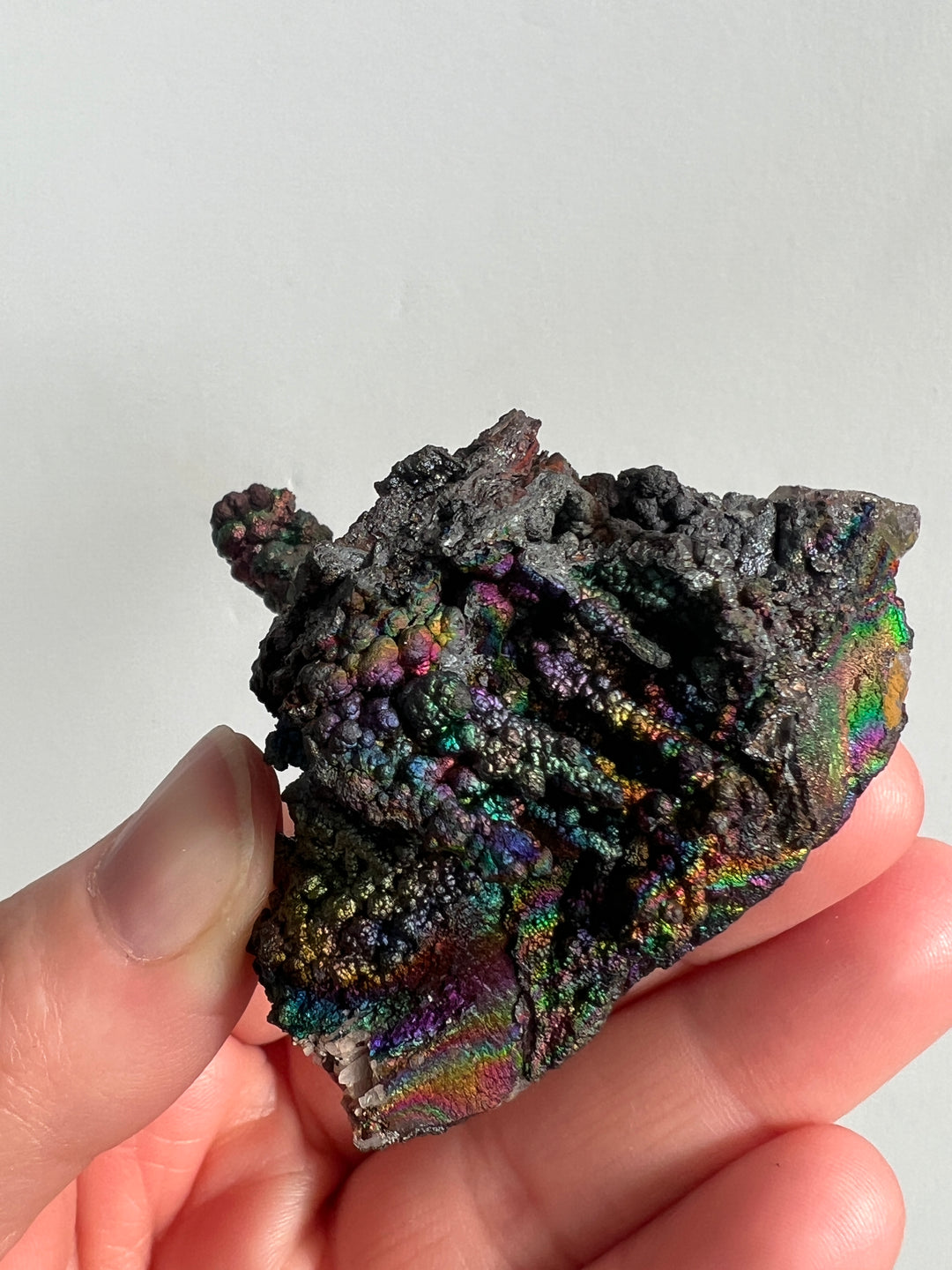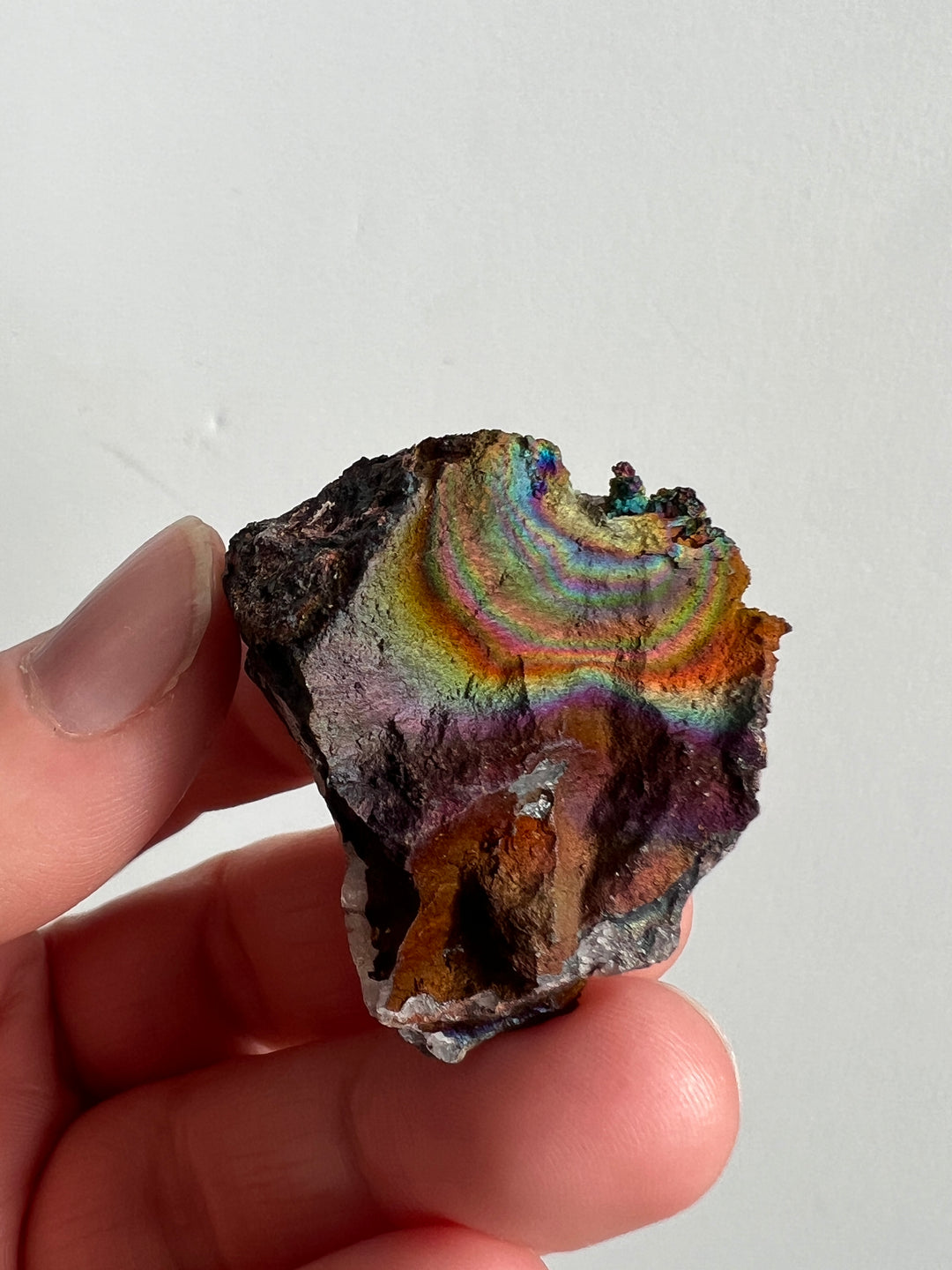Turgite | FAQ
Q: What is Turgite? A: Turgite is a mineraloid that is not recognized as a distinct mineral species but is rather a mixture of hematite (Fe2O3) and goethite (FeOOH). It is known for its iridescent surface, displaying a range of colors from deep reds and purples to greens and blues. Turgite's iridescence is due to the interference of light reflecting from the thin layers of hematite and goethite.
Q: What healing properties are attributed to Turgite? A: Turgite is believed to have grounding and protective qualities. It is thought to strengthen one’s connection to the Earth, provide stability and support during times of stress, and to absorb negative energy. It's also considered helpful in enhancing personal strength and endurance.
Q: How can Turgite be incorporated into meditation or spiritual practices? A: In meditation and spiritual practices, Turgite is used for grounding, balancing energy, and enhancing focus. Its connection to the earth is believed to help in stabilizing and centering one's energy, making it easier to connect with higher spiritual realms.
Q: What unique characteristics does Turgite possess? A: The most distinctive feature of Turgite is its vibrant iridescent sheen, which can display a spectrum of colors depending on the angle of light. This iridescence adds a unique visual appeal to the mineraloid.
Q: What is the Mohs hardness of Turgite? A: The hardness of Turgite can vary since it's a mixture of hematite and goethite. Hematite has a Mohs hardness of about 5.5 to 6.5, while goethite is softer, around 5 to 5.5. Therefore, Turgite's hardness is likely to be in this range.
Q: Is Turgite suitable for use in jewelry making? A: Turgite can be used in jewelry, but due to its variable hardness and potential brittleness, it is often best suited for pieces that are not subject to frequent wear and tear, like pendants or earrings.
Q: How should Turgite be cared for and cleaned? A: Turgite should be handled gently and cleaned with a soft, dry cloth. Avoid using water, chemicals, or ultrasonic cleaners, as they may damage the iridescent surface.
Q: What significance do the color and iridescence of Turgite hold? A: The iridescence and colorful sheen of Turgite are often associated with creativity, energy, and transformation. It's believed to stimulate the imagination and to help in embracing life's changes.
Q: What metaphysical properties are associated with Turgite? A: Metaphysically, Turgite is considered a stone of transformation and grounding. It's said to enhance personal strength, provide emotional support, and to assist in overcoming fears and doubts.
Q: What are the geological properties of Turgite? A: Geologically, Turgite forms through the oxidation of iron minerals, primarily hematite and goethite. This process results in the layered structure that creates its distinctive iridescent surface.
Q: Can you explain the scientific properties of Turgite? A: Scientifically, Turgite is a mixture of iron oxides and hydroxides. It exhibits properties of both hematite and goethite, including their crystal structures and chemical compositions.
Q: What is the mineral composition of Turgite? A: Turgite is composed of iron oxide (hematite) and iron hydroxide (goethite). The exact composition can vary depending on the proportions of these two components.
Q: Does Turgite fade or change color over time? A: Turgite's color is generally stable, but it may be sensitive to high humidity or prolonged exposure to water, which could affect its iridescent surface.
Q: How can I distinguish between real and fake Turgite? A: Genuine Turgite has a natural, iridescent sheen with color changes visible at different angles. Fakes might use artificial coatings to mimic this effect but often lack the natural depth and variation of color.
Q: How is Turgite formed? A: Turgite forms through the oxidation of iron minerals, where hematite and goethite interact and create layered structures. This usually occurs in environments with high iron content and oxidation potential.
Q: Are there different types or variations of Turgite? A: Variations in Turgite primarily involve differences in the intensity of iridescence and the color range displayed. The proportions of hematite and goethite can also vary, affecting its appearance and properties.
Q: What's the historical significance of Turgite? A: Turgite does not have a widely known historical significance but has been valued by mineral collectors and those interested in its metaphysical properties for its unique appearance and energy.
Q: What is the origin of Turgite? A: The term "Turgite" does not refer to a specific geographic location but rather describes the physical and chemical characteristics of this iron oxide mixture.
Q: Where is Turgite typically found? A: Turgite can be found in regions with iron ore deposits, particularly where conditions favor the oxidation of hematite and goethite. It's not exclusive to a specific locality.
Q: How rare is Turgite? A: The rarity of Turgite can vary depending on the quality of iridescence and the specimen's overall appearance. Fine examples with vibrant color play are sought after by collectors and can be considered relatively rare.









